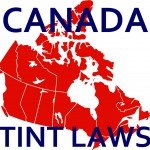Canada window tint laws are different in each province, and this article provides all relevant information about window tinting laws in Ontario.
Ontario window tint laws overview:
- Windshield: No tint recommended. 30% VLT strip on top 7.5 centimeters may be allowed.
- Front side windows: No tint recommended. 30% VLT may be permitted.
- Back side windows: Any tint darkness can be used.
- Rear window: Any tint darkness can be used.
Ontario laws do not expressly specify whether front window tinting is legal or not.
According to Ontario Highway Safety Act (linked below), you may not drive a vehicle if:
[…] any window to the direct left or right of the driver’s seat […] substantially obscures the interior of the motor vehicle when viewed from outside the motor vehicle.
We strongly suggest not installing window tint on windshield or front side windows, as any percentage could technically result in a fine.
It is up to each individual police officer to determine whether your tint “substantially” obscures vision inside your vehicle.
Windshield:
Newest Ontario vehicle inspection regulations (linked below, page 76) state that vehicles manufactured after January 1st, 2017 may not have any aftermarket window tint applied to the windshield.
Only OEM (Original Equipment Manufacturer) or factory-made windows may have 70% VLT (30% opacity/light block), and this tinting must not extend more than 75mm from top of windshield (AS-1 line).
Front side windows:
Front side windows may have 70% VLT (visible light transmission) only if originally manufactured as such.
Vehicle inspection regulations also permit 70% VLT, meaning your vehicle will pass inspection if front side windows allow over 70% light transmittance.
However, Ontario law does not expressly allow aftermarket tinting on front side windows nor does it specify exact VLT percentage.
It only says windows must not substantially reduce vision inside the vehicle.
Thus, tinting front side windows should be done only at your own risk.
Using high VLT tint such as 90% means most police officers won’t bother you, but be aware that they technically can.
Use 70% VLT only if you are certain OEM windows are not already tinted.
Back windows:
Ontario law does not restrict tinting and darkness on your back side windows and rear window.
Ontario’s traffic law also requires having left and right external rear view mirrors in case rear window is tinted (sec. 74.2).
Those of you who research Ontario window tint laws elsewhere please ensure you are reading up to date content.
Ontario amended tinting laws in July 2016, and new regulations are in effect since January 1st, 2017.
Our information is up to date, but please keep in mind many other unofficial sources still provide inaccurate and unlawful information! Trust but verify!
Other Ontario tint laws:
- Reflective tint: Not allowed.
- Side mirrors: Required if rear window is tinted.
- Medical exemptions: None.
- Certificate requirements: None.
- Tint sticker requirements: None.
Penalties for unlawful car window tint in Ontario result in a $85 – $500 fine, and there may be additional surcharges and fees involved.
Ontario window tint sources
Ontario Highway Traffic Act, R.S.O. 1990, CHAPTER H.8, Equipment obstructing view (see sections 73 and 74)
Ontario Vehicle Inspection Standard (.pdf file, 865kb, scroll to page 76; alternate link, last retrieved Jan 2022).
Car window tint laws in Canada
Each Canadian province has its own rules and regulations, and violating vehicle equipment laws can get you cited even when visiting other provinces.
See our main Canada Window Tint Laws page for an overview of car tinting laws for all provinces and to find out if Alberta Window Tint Laws can result in fines in the rest of Canada.
